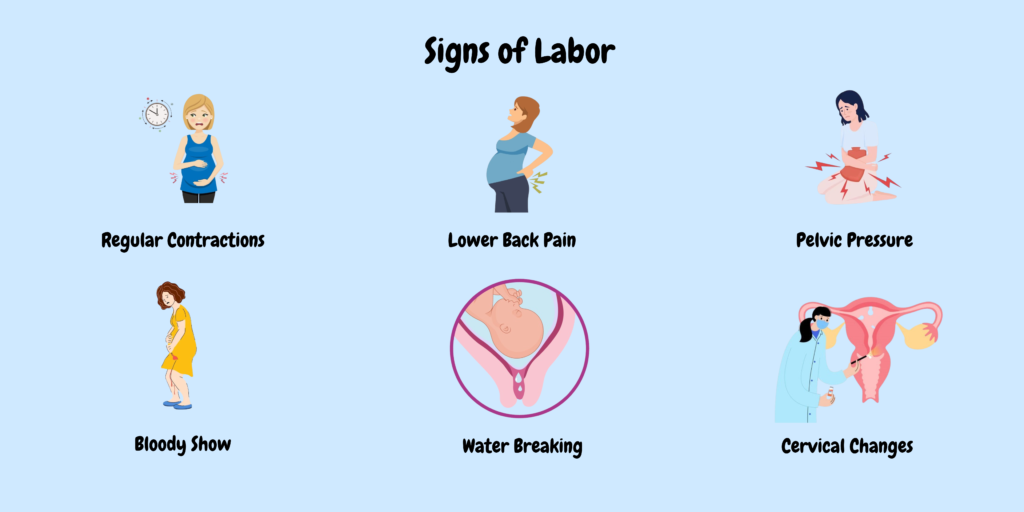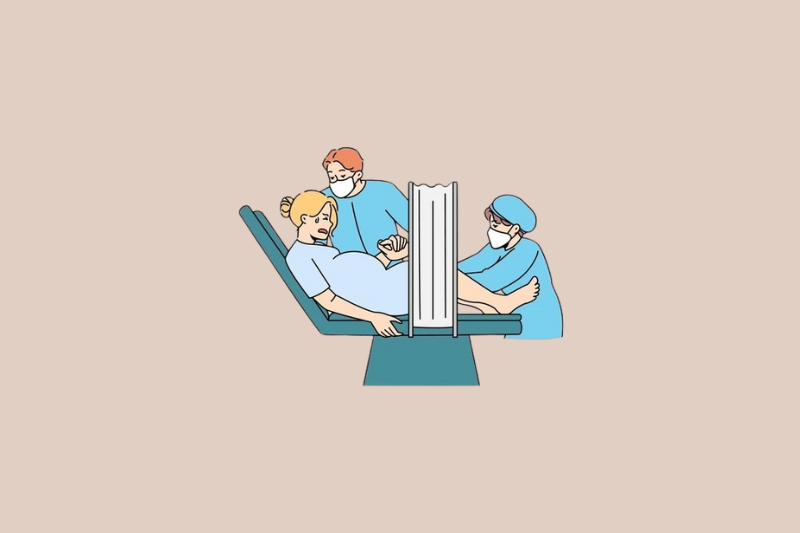Signs of Labor
Labor refers to the process by which the body undergoes the changes to give birth to the baby. It is associated with the physical changes, marked by the onset of regular contractions that help to dilate the cervix and push the baby out through the birth canal. Labor is generally divided into three stages: the first stage involves the gradual opening of the cervix; the second stage encompasses the actual delivery of the baby; and the third stage involves the expulsion of the placenta. This process can vary in duration and intensity for each individual, influenced by factors such as the mother’s health, the baby’s position, and whether it is a first-time birth. It is essential to have understanding of labor so, that you can make decisions accordingly.
On this page
1. What are signs of Labor?

Signs of labor can be different for different individuals, but common signs include:
- Regular Contractions: Contractions become more frequent, intense, and regular, often lasting 30 to 70 seconds.
- Lower Back Pain: Persistent or rhythmic lower back pain that may come and go.
- Pelvic Pressure: Increased pressure in the pelvic area as the baby moves down into the birth canal.
- Bloody Show: A discharge that may be pink or blood-tinged, indicating that the cervix is starting to change.
- Water Breaking: A sudden release of amniotic fluid, which can occur as a gush or a slow leak.
- Cervical Changes: Effacement (thinning) and dilation (opening) of the cervix, often checked by a healthcare provider.
If any of these signs occur, especially regular contractions or water breaking, it’s important to contact a healthcare provider.
2. What are False Labor and Braxton-Hicks contractions?
Braxton-Hicks contractions are often called “practice contractions.” They are usually irregular and infrequent, feeling like a tightening of the abdomen. These contractions can start as early as the second trimester and are generally not a sign that labor is approaching. They may become more noticeable as the pregnancy progresses, especially in the third trimester, but they do not lead to cervical dilation.
False labor, on the other hand, can involve contractions that feel similar to those of true labor but do not result in cervical changes. These contractions may vary in intensity and frequency and often go away with rest, hydration, or changes in activity. Unlike true labor, false labor does not indicate that the baby is about to be born.
Both Braxton-Hicks contractions and false labor can be confusing for expecting parents, but they serve as part of the body’s preparation for the delivery. If you are confused, that whether labor has begun, it’s advisable to consult your healthcare provider.
3. What are the stages of Labor?
Labor is divided into three main stages, which are as follows:
- First Stage: This stage is primarily focused on cervical dilation and is further divided into three phases:
- Early Labor (Latent Phase): The cervix dilates from 0 to about 3 cm. Contractions are usually mild and irregular, and can last several hours to days. This phase may be accompanied by some discomfort and the “bloody show.”
- Active Labor: The cervix dilates from about 4 to 7 cm. Contractions become more intense, regular, and closer together, typically lasting 45 to 60 seconds. This is often when women go to the hospital or birthing center.
- Transition: The cervix dilates from 8 to 10 cm. This phase is often the most intense, with strong contractions occurring every two to three minutes. Women may experience significant discomfort and pressure.
- Second Stage: This stage begins once the cervix is fully dilated at 10 cm and ends with the birth of the baby. It involves pushing, where the mother actively works with contractions to help the baby go out the birth canal. This stage can last from a few minutes to several hours, depending on various factors, including the position of the baby and the mother’s energy levels.
- Third Stage: This stage occurs after the birth of the baby and involves the delivery of the placenta. It usually lasts from a few minutes to half an hour. During this time, the uterus continues to contract to help detach and expel the placenta, along with any remaining tissue.
Understanding these stages can help expectant mothers prepare for the birth process and understand what to expect during delivery.
